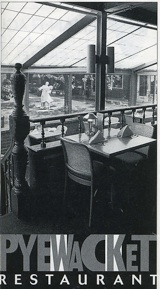
Davis, Lucy Carol. “Restaurants and Shops.” LCDA Architecture. September 15, 2007. Accessed November 4, 2018. http://www.lcdaarchitecture.com/Commercial/Restaurants_and_Shops.html.
Pyewacket was one of the first vegetarian restaurants in the Chapel Hill area that opened in 1977. It is described in the Metro Gourmet as “a bastion of good vegetarian cooking and, for a generation, the quintessential Chapel Hill lunch spot” [4]. It was located at 431 W. Franklin Street which is now the location of Kipos upscale Greek restaurant. Today, Franklin Street is a hub for students to grab food when they are treating themselves to something outside of the dining hall, and it is interesting to think that between 1977 and 2002, this was one of the most popular spots to eat.
The fact that this was the first fully vegetarian restaurant adds to the food story of Chapel Hill because it shows that in 1977, people were becoming aware of health implications surrounding meat. In the late 1950s, the American Heart Association called attention to a relationship linking dietary cholesterol, saturated fat, and total fat to cardiovascular disease which lead to an increase in vegetarianism [1]. An increase in diet fads which include vegetarianism is mentioned in American Appetites as the Japanese philosopher, George Ohsawa, became popular for his vegetarian, ecologically and spiritually centered macrobiotic diet [5]. Today, various diet trends are still popular, especially among millennials, and vegetarian, vegan, and health food restaurants are continuing to gain popularity in the local Chapel Hill area.
Although not a reliable primary or secondary source, the “Chapel Hill Memories” website shows interesting reviews of the restaurant which everybody loved up until its closing. People on this website express their confusion as to why such a popular and delicious restaurant could be going out of business. There are even posts from 2012, which was 10 years past Pyewacket closing, that continue to express sentiment for the loss of such a great restaurant. A noticeable number of people talk about the “Lemon Tamari” salad dressing as the best salad dressing they have ever had, and a staple that they miss most about the restaurant [3].
The restaurant had a greenhouse dining room which overlooked a courtyard as seen in the photo [2]. The restaurant was known for its calming and casual atmosphere, and in fact it was the change in that atmosphere that lead to its closing. According to Metro Gourmet when Pyewacket tried to make its interior more stylish and its food more rich, it lost the quintessential lunch atmosphere that people loved which lead to its closing [4]. By the time it closed in 2002, it was no longer a vegetarian restaurant and it had a much more complex menu than the original. The 2002 menu, which can be found online, even has a late night menu with burgers and nachos which shows the vast transition from a vegetarian cafe to a restaurant catering to college kids [6].
[1] Daniel, Carrie R et al. “Trends in meat consumption in the USA” Public health nutrition vol. 14,4 (2010): 575-83.
[2] Davis, Lucy Carol. “Restaurants and Shops.” LCDA Architecture. September 15, 2007. Accessed November 4, 2018. http://www.lcdaarchitecture.com/Commercial/Restaurants_and_Shops.html.
[3] Mann, Charly. “The Pyewacket Restaurant (1977 – 2002).” Chapel Hill Memories. February 15, 2012. Accessed November 4, 2018. http://www.chapelhillmemories.com/cat/8/62.
[4] Neal, Moreton. “Another Look at Another Thyme.” Metro Gourmet, May 2003, 60-63. http://aquadesign.us/_samples/MetroGourmentMay03.pdf.
[5] “Politics, Protest, and Food.” In American Appetites: A Documentary Reader, edited by Wallach Jennifer Jensen and Swindall Lindsey R., 101-22. Fayetteville: University of Arkansas Press, 2014. doi:10.2307/j.ctt1ffjhj8.11.
[6] Pyewacket Restaurant Menu. Accessed November 4, 2018. http://www.trianglerestaurants.com/Pyewacket/.
Suzanne Nevant